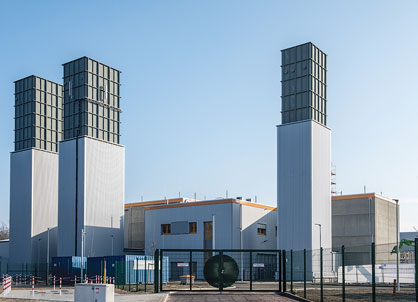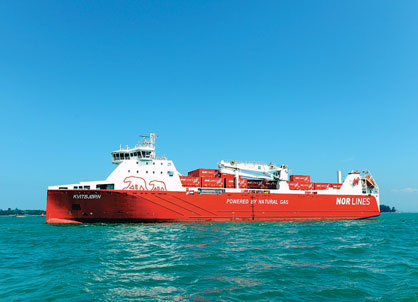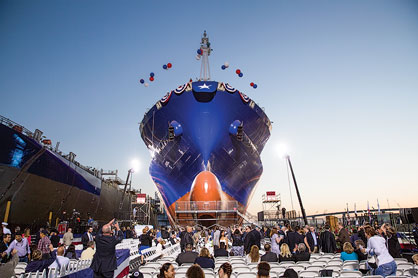Gas processing news
LNG fuel gas system for Baltic Sea ferry
The Linde Group, via its Swedish Engineering subsidiary, Cryo AB, has been awarded a contract by Meyer Turku Shipyard of Finland to build an LNG fuel gas system for a next-generation high-speed ferry being built for AS Tallink Grupp.
The LNG system consists of two horizontal, vacuum-insulated 300-m³ tanks, plus gas handling and control systems, and it will supply natural gas to the vessel’s dual-fuel engines.
The ferry will operate in the Baltic Sea between Helsinki, Finland and Tallinn, Estonia, and it has been designed to comply with European Emission Control Area limits because it uses LNG as fuel.
The ship has a capacity of 2,850 passengers and will be capable of speeds up to 27 knots, which is partly attributable to its innovative hull shape that is engineered specifically to increase fuel efficiency.
The vessel will be delivered at the start of 2017.
BASF to sublicense ExxonMobil technology
A technology agreement between BASF and ExxonMobil Research and Engineering Co. (EMRE) provides BASF with the right to sublicense EMRE’s FLEXSORB technology and supply the related solvent to third parties.
The technology is known for its selective removal of H2S in the presence of CO2. The selectivity advantage allows for the achievement of high H2S removal at low solvent-circulation rates, resulting in lower energy consumption compared to conventional processes. The process is characterized by low corrosion and lower foaming compared to conventional gas treating solvents. The FLEXSORB technology has been used in over 120 reference plants since 1983.
Turbine test center opens in Germany
 |
Siemens has commissioned its Clean Energy Center in Ludwigsfelde, Germany. The new burner test center will examine and validate combustion processes in gas turbines to enhance the efficiency of Siemens gas turbines and improve their flexibility while using different liquid and gas fuels. Siemens invested approximately €100 MM in this new research and development site, which is part of the Siemens Berlin gas turbine manufacturing plant location.
Siemens’ gas turbine portfolio includes models with capacities of 5 MW to 400 MW. The 36,000-m2 test center will play a key role in developing new gas turbines and modernizing existing models. There are now several test cells available in Ludwigsfelde in which combustion processes can be analyzed and optimized under realistic conditions.
These tests will determine measured variables, such as output, efficiency, emission levels and flame stability. The goal is to qualify gas turbines for new fuels so that new applications can be tapped. Siemens tests the behavior of burners and gas turbines when burning contaminated gases; low-calorific process gases, such as coke-oven gas and blast-furnace gas; or liquid fuels (crude oil, naphtha, heavy fuel oil and other condensates).
Enable Midstream completes Bradley plant
Enable Midstream Partners LP has started operations at its new Bradley processing plant in Grady County, Oklahoma, with an inlet capacity of 200 MMcfd of natural gas. The plant removes water, condensate and NGL from natural gas, providing transmission-quality gas, marketable NGL and stabilized condensate. The processing plant has a combined 30,250 hp for inlet, residue and refrigeration compression.
In the fourth quarter of 2014, the company’s board of directors approved building a second 200-MMcfd plant in Grady County, southwest of Oklahoma City. It is under construction and is expected to be operational in the first quarter of 2016. At this point, Enable Midstream’s super-header processing system will be connected to nine plants and have a capacity of nearly 1.7 Bcfd.
LPG export capacity from Houston increases
Enterprise Products Partners LP has completed an expansion project at its LPG export terminal at the Houston Ship Channel. The facility’s capacity for loading fully refrigerated, low-ethane propane will now increase to 9 MMbbl/month. Enhancements to existing refrigeration infrastructure, designed to add 2,500 bbl/hr (1.5 MMbbl/month) of incremental loading capacity, will allow Enterprise to accommodate an additional three ships per month.
Construction is also progressing on a new refrigeration train that will increase loading rates by another 11 Mbbl/hr. This train is on schedule for completion in the fourth quarter of 2015. Once the final expansion phase has been completed, Enterprise will have the capability to load up to 16 MMbbl/month of LPG, which equates to 29 vessels.
Enterprise’s LPG terminal has helped transform the US into the largest propane exporter in the world. It has approximately 1,800 cargoes scheduled from 2015 to 2024. To help ensure adequate supply to the docks, the partnership is in the final stages of completing a dedicated LPG pipeline from Mont Belvieu, Texas to the terminal.
Valerus recognized for safety
 |
Valerus, a member of SNC-Lavalin Group a provider of oil and gas handling services and equipment, has been awarded a Gas Processors Suppliers Association (GPSA) company safety award. The award recognizes Valerus’ outstanding safety performance and commitment to industry safety programs.
GPSA awards are based on the previous year’s Occupational Safety and Health Administration (OSHA) records, company size, and a history of active safety programs and displaying safety improvement. Valerus was one of eight companies recognized at the 2015 Gas Processors Association Annual Convention in San Antonio, Texas. The honor was accepted by Jim Gill, COO for Valerus.
Gas contract alliance for GTL plant
CompactGTL has an agreement with KazakhOil Aktobe for the supply of gas for its first commercial GTL plant in Kazakhstan. KazakhOil Aktobe (a JV between Lukoil, KazMunaiGas and Sinopec) and CompactGTL have successfully negotiated all of the contract’s commercial terms. The contract has been submitted to the respective shareholder boards for approval.
The CompactGTL plant, which will be located in the Aktobe region of Kazakhstan, will take gas that would have otherwise been flared and convert it into synthetic diesel. The plant is scheduled to become operational in 2018.
This announcement follows the signing of a breakthrough memorandum with the Republic of Kazakhstan’s Ministry of Oil and Gas in March 2014 for developing the world’s first small-scale GTL plant. The plant will address the issue of gas flaring and produce fuel for local consumption.
Longest sea journey powered by LNG
 |
Propelled by a Rolls-Royce pure-gas engine, Nor Lines’ Kvitbjørn has reportedly become the world’s first vessel to operate between Asia and Europe solely on LNG. Kvitbjørn’s naming ceremony in Stavanger, Norway celebrates Nor Lines’ 5,000-dwt short sea cargo vessel, built to Rolls-Royce’s Environship concept.
The ship sailed to Norway from Tsuji Heavy Industries’ shipyard in Jiangsu, China, via Singapore. It stopped for LNG bunkerings in Cochin, India and in Cartagena, Spain. This voyage, reported to be the longest voyage ever undertaken by a vessel powered solely by LNG, was completed in Bergen, Norway at the end of March.
The Environship concept can be adapted for different ship types, and it incorporates a range of Rolls-Royce technologies to deliver efficiency savings for ship owners. These technologies include a Bergen engine powered by LNG, the Promas combined rudder and propeller, a hybrid shaft generator to optimize electrical power use and a wave-piercing hull design. The Environship concept’s combined technologies reduce CO2 emissions by up to 40% compared to similar diesel-powered vessels, depending on the operational profile.
Kvitbjørn is about to enter operation, delivering cargo in ports between Hamburg, Germany, the Netherlands and Hammerfest, Norway. Nor Lines expects to take delivery of sister ship Kvitnos in June.
World’s first LNG-powered container ship
 |
The world’s first LNG-fueled container ship, the Isla Bella, has been launched in San Diego, California. The ship’s owner, TOTE, in partnership with General Dynamics NASSCO, has celebrated the completion of the first of two Marlin class container ships headed to Puerto Rico later this year.
Using LNG as a marine fuel in the US defines a major shift for the industry. By switching to LNG, TOTE is reducing NOx emissions by 98%, SOx by 97%, CO2 by 72% and particulate matter by 60% in the Puerto Rico trade.
The Marlin class vessels have attracted international attention as the first cargo ships in the world to run on natural gas. In addition to their improved environmental profile, the vessels will represent a new standard in safety.
The Isla Bella will enter service in the fourth quarter of 2015 between Jacksonville, Florida and San Juan, Puerto Rico. The second Marlin class vessel will be launched in the third quarter of 2015 and will enter service in the first quarter of 2016.
Valves for LNG carrier reliquefaction
 |
Bestobell Marine has secured two contracts for its valves to be fitted in the LNG reliquefaction systems that will be installed on two LNG carriers that are being built at the Hyundai Heavy Industries (HHI) shipyard in South Korea for Knutsen OAS Shipping of Norway.
Similar systems will be installed on two sister ships being built by Imabari Shipbuilding Group in Japan for Elcano.
The company has previously supplied cryogenic globe and check valves for regasification systems, including for the five Hoegh floating storage regasification units (FSRUs)
that have been constructed at the HHI shipyard.
Bestobell Marine has fitted more than 35,000 cryogenic valves on ships and has recently developed a new range of high-pressure globe valves that are fitted in LNG fuel gas systems for MAN ME-GI engines, where natural gas is injected into the engine at a pressure of over 300 bar.
First gas-to-ethylene demo plant opens
The startup of Siluria Technologies’ demonstration plant in La Porte, Texas marks the first large-scale production of ethylene directly from natural gas through oxidative coupling
of methane (OCM).
The plant, which is wholly owned by Siluria, is co-located at a plant operated by Braskem America Inc. It is the final scale-up of the OCM process technology and paves the way for Siluria to deploy commercial-scale plants in the 2017/2018 time frame.
Siluria’s OCM technology is said to be the first commercially viable process to directly convert natural gas into ethylene. The conversion of methane to ethylene using OCM has been a sought-after goal of the chemical industry for more than 30 years because of its promise to add value to natural gas resources and reduce the costs of chemicals, plastics and fuels production.
Siluria’s catalytic process is said to be more scalable, efficient, environmentally friendly and cost-effective in many settings than are current production methods.
This breakthrough was achieved by combining new innovations in catalyst development with advances in catalyst screening. Siluria has previously announced its partnership with The Linde Group to offer licenses to the ethylene industry worldwide.
Technip wins contract for Peru pipeline
Tipiel SA, Technip’s subsidiary in Colombia, has been awarded a FEED and detailed engineering design contract by the Consorcio Constructor Ductos del Sur. The contract, valued at just under €50 MM, covers the development of a new gas pipeline to transport gas from the Camisea field to southern Peru.
Launched by the Peruvian government, the project consists of more than 1,700 km of 32-in. gas pipeline. Its purpose is to improve the existing Peruvian energy network, contributing to the development of an energy node and petrochemical hub in southern Peru.
LNG system for portable plants
Dresser-Rand’s LNGo natural gas conversion system for the LNG market combines the company’s MOS reciprocating compressor, Guascor gas engine and Enginuity control system technologies in a portable, small-footprint package that can be placed on well pads, gas flares and similar sites.
The system allows for small standalone plants that are portable and can be moved to support changing requirements and needs. Sized to produce approximately 6 Mgpd–8 Mgpd of LNG, the LNGo system can be used in upstream, midstream and downstream applications.




Comments